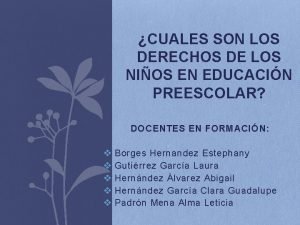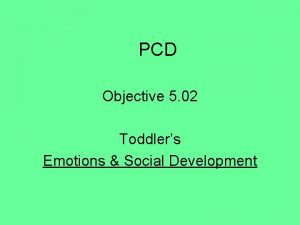TIKES Toddlers Into Kindergarteners Emotions Study Los nios

- Slides: 1

TIKES: Toddlers Into Kindergarteners: Emotions Study Los niños en el Jardín Infantil: Estudio de las Emociones Kristin A. Buss Project Directora del Proyecto What is TIKES? We started TIKES in State College in 2006. The TIKES study in Harrisburg started in 2008. We have had a total of 206 families participate in the TIKES study. ¿Qué es TIKES? Nosotros iniciamos TIKES en State College en el 2006. El estudio TIKES en Harrisburg dio inicio en el 2008. Un total de 206 familias han participado en el estudio TIKES. We wanted to understand how children’s emotions develop and how children adjust to kindergarten. We were interested in reactions to things that are new or unfamiliar. Strong emotions, especially fearfulness, to new things can make it harder to adjust to kindergarten. Queríamos entender cómo se desarrollan las emociones de los niños y cómo los niños se adaptan al jardín infantil. Estábamos interesado en las reacciones tanto a las cosas nuevas como a las desconocidas. Las emociones fuertes, especialmente el temor a las cosas nuevas, puede hacer mas difícil el adaptarse al jardín de infantil. Who Participated in Harrisburg? 45 families with 2 -5 year old children Families were paid $50 for lab visits and $25 for surveys. ¿Quién participo en Harrisburg? 45 familias con niños de 2 -5 años de edad Se les pagó a las familias $50 por las visitas de laboratorio y $25 por las encuestas. What Did Children Do? Children and parents visited our lab at PACT at age 2 and age 5. We videotaped children playing with new objects and people. ¿Qué hicieron los niños? Los niños y los padres visitaron nuestro laboratorio en PACT a la edad de 2 y 5 años. Grabamos a los niños jugando con objetos nuevos y con personas. What Did Parents Do? Parents and children played games together during both visits. Parents also filled out surveys to tell us about their child’s emotions, behaviors, and their own personalities when children were 2, 3, 4, and 5. Parents were also interviewed about their child’s behavior, and potential problems, at age 2 and age 6. ¿Qué hicieron los padres? Los padres y los niños jugaron juntos durante ambas visitas. Los padres también llenaron encuestas para informarnos de las emociones, comportamiento de sus hijos y de sus propias personalidades cuando los niños tenían 2, 3, 4 y 5 años de edad. Los padres fueron entrevistados sobre el comportamiento de sus hijos y problemas potenciales a la edad de 2 y 6 años. What have we Learned? At age 2, most of the children were afraid of the robot and spider. About half of the children were shy with the strangers, but only a few children were wary or scared of the puppets and clown. ¿Qué hemos aprendido? A la edad de 2 años, la mayoría de los niños le tenían miedo al robot y a la araña. Cerca de la mitad de los niños eran tímidos con los extraños, pero sólo unos cuantos niños eran cautelosos y tenían miedo de los títeres o los payasos. Some children were afraid of all these situations. These children were more fearful in preschool and in kindergarten. Parents told us that these children have more problems with anxiety. They were more cautious with peers and did not make friends easily. Algunos niños tenían miedo de todas estas situaciones. Estos niños eran más temerosos en el preescolar y en el jardín infantil. Los padres nos dijeron que estos niños tienen más problemas de ansiedad. Eran más cautelosos con sus compañeros y no hacen amigos fácilmente. We know from our other studies: that fearful children have difficulty adjusting to new things, like kindergarten. anxiety problems can increase as children get older. Sabemos de nuestros otros estudios: que los niños temerosos tienen dificultad para adaptarse a cosas nuevas como el jardín infantil. Los problemas de ansiedad pueden aumentar a medida que los niños crecen. We extend a special thank you to participating families and the daycare centers that let us reach out to their families. Extendemos nuestro especial agradecimiento a las familias participantes y los centros de cuidado infantil que nos permitieron alcanzar a sus familias. Basic Steps Daycare Center, Bright Beginnings Child Development Center, Colorful Future Early Learning Centers, Grace Learning Center, Hansel & Gretel Early Learning Center, Hildebrandt Learning Center, Loving Hands Family Daycare, Penbrook Learning Center, Pollock Childcare Center at HACC, Sawyers Group Daycare Home, Strawberry Garden Early Childhood Learning Center, and The Growing Center

